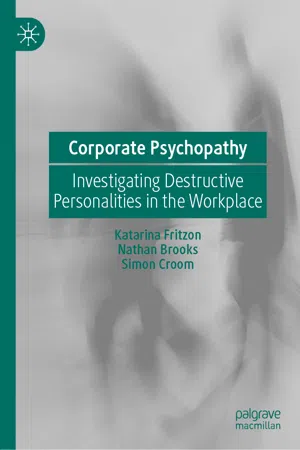Definition and Characteristics of Psychopathy
The clinical construct of psychopathy is defined by a constellation of interpersonal, affective and lifestyle characteristics (Cleckley, 1941; Hare, 1999b). Traits associated with psychopathy include: insincerity, pathological lying, egocentricity, unreliability, lack of remorse and an inability to experience empathy or concern for others (Cleckley, 1941; Hare, 1999b; Hare & McPherson, 1984). Psychopathy has been described as one of the most important forensic concepts in the early stages of the twenty-first century (Monahan et al., 2006). Experts suggest that psychopathic traits are best viewed based on a continuum, also allowing for research to examine the construct outside of institutional settings (Dutton, 2012; Edens, Marcus, Lilienfeld, & Poythress, 2006; Hare & Neumann, 2010).
While the violence and criminal behaviour that is commonly associated with psychopathy is of paramount concern to society, many individuals with psychopathy never commit acts of violence or serve a period of incarceration in a correctional facility (Dutton, 2012; Hare, 1999a). Indeed, Hickey (2010) suggested that psychopaths might be more likely to operate as white-collar criminals than violent murderers. However, research has overwhelmingly focused on incarcerated populations, with prevalence rates for correctional inmates ranging from 15 to 25% (Hare, 1996), while the community prevalence (i.e. the general population) is estimated to be only approximately one in 100 (Hare, 1999b). More recently, literature has turned towards examining manifestations of psychopathy in high-functioning populations, such as the corporate and political sectors, and three key strands of research have emerged as crucial in understanding this “new” form of psychopathy. These are: (1) theoretical and conceptual explanations for high-functioning psychopathy; (2) the core defining personality, cognitive and affective components of high-functioning psychopathy, including differences between the high-functioning and low-functioning criminal psychopath; and (3) the most appropriate ways of measuring or assessing psychopathy in noncriminal populations. Of practical concern, the need for appropriate assessment tools is illustrated by the vast differences reported in prevalence rates, ranging from 3% (Babiak, Neumann, & Hare, 2010) using the short form of the Psychopathy Checklist-Revised (PCL-SV; Hart, Cox, & Hare, 1995) to 12% (Croom, 2017) using the Psychopathic Personality Inventory-Revised (PPI-R; Lilienfeld & Widows, 2005).
Psychopathy has always been recognised as a paradoxical condition, with individuals being devoid of outwardly obvious signs and symptoms of mental disorder, while possessing significant emotional and cognitive deficits (Cleckley, 1988, Lilienfeld et al., 2012, Lykken, 1995). Cleckley (1941, 1976) described psychopathic individuals as charming, fearless and bold, interpersonally dominant, with intact intellectual functioning and low anxiety, yet also reckless and dishonest. Extending on this, Hare (1999b, 2003) described psychopathy as characterised by interpersonal, affective, lifestyle and antisocial features, with much of Hare’s conceptualisation of psychopathy, and indeed subsequent research, developed from North American criminal offenders. The current chapter will focus on a broad overview of the psychopathic personality and will present research from various perspectives on the aetiological foundations of the construct. Subsequent chapters will highlight the empirical findings on the sequelae of psychopathy in relation to its criminal and noncriminal manifestations.
Brief History of the Psychopathy Construct
German psychiatrist Julius Ludwig August Koch in his monograph Die Psychopathischen Minderwertigkeiten (Psychopathic Inferiorities) published in 1891 was one of the first people to introduce the term, psychopath. Koch in his preliminary writing described the “psychopathic inferiorities” which were marked by differences in congenital and acquired forms. In similar vein to Koch, Henderson (1939) in his book, Psychopathic States, described psychopaths as suffering from an illness causing badness and antisocial behaviour for which there was no known explanation. The first comprehensive clinical conceptualisation of psychopathy (Blonigen, Hicks, Krueger, Patrick, & Iacono, 2006; Hicks, Markon, Patrick, Krueger, & Newman, 2004) was provided by Hervey Cleckley (1941) in his book The Mask of Sanity. Cleckley’s work on psychopathy was based on his widespread experience working with psychiatric patients at a Georgia Hospital (Cleckley, 1941; Skeem, Polaschek, Patrick, & Lilienfeld, 2011). Cleckley identified 16 key characteristics that he believed captured the psychopathic personality. The title of Cleckley’s book, the “Mask of Sanity”, refers to the ability of psychopaths to present as personable, confident and well adjusted in comparison with other psychiatric patients; however, behind the mask, a character is revealed with a severe underlying pathology evident through their actions and attitudes (Cleckley, 1941, 1976; Skeem et al., 2011). Cleckley believed that psychopaths were not of unsound mind or suffering from any form of insanity of psychosis, but rather were calculated and reasoned in their actions, having limited moral regard for any consequences.
Building on the work of Cleckley (1941), Dr. Robert Hare operationalised the construct of psychopathy, identifying 22 core characteristics that he argued depicted psychopathic personality (Hare, 1980). These characteristics were developed into a criterion-based protocol, consisting of an interview and review of collateral documentation to assess the presence of psychopath. Hare (1980) called the measure the Psychopathy Checklist (PCL; Hare, 1980). After its introduction, the PCL was revised by Hare (PCL-R; Hare, 1991, 2003) and reduced to a 20-item checklist of characteristics that defined psychopathy. Table 1.1 shows a side-by-side comparison of Cleckley’s 16 characteristics and Hare’s final 20 characteristics, and highlights some important differences between the two—namely that Clec...
